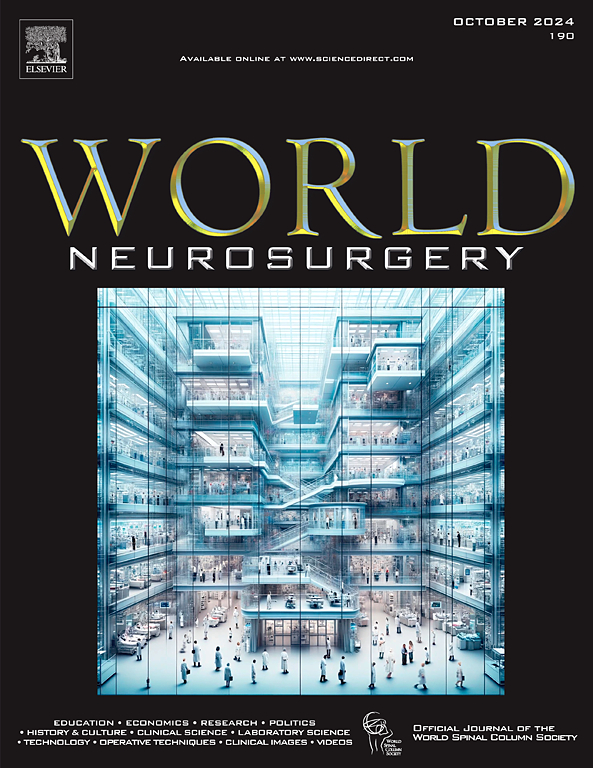简化S1椎体骨质量评分预测腰椎滑脱患者螺钉松动。
IF 1.9
4区 医学
Q3 CLINICAL NEUROLOGY
引用次数: 0
摘要
目的:以定量计算机断层扫描(QCT)作为标准参考,探讨S1椎体骨质量(VBQ)评分是否可以替代传统的VBQ评分预测腰椎滑脱行椎间孔腰椎椎体间融合术(TLIF)患者螺钉松动。方法:我们回顾了2012年至2021年在我们中心接受单节段TLIF治疗腰椎滑脱的165例患者。收集了人口统计学和放射学数据。为了确定影响椎弓根螺钉松动的独立因素,我们进行了单因素分析和多因素logistic回归。采用ROC分析评估预测能力。结果:16.3%的患者在至少24个月的随访中发生螺钉松动。两组在手术水平(L5-S1)、传统VBQ、S1 VBQ、QCT值方面差异有统计学意义。QCT值、传统VBQ评分和S1 VBQ评分是螺钉松动的独立危险因素。ROC分析显示,QCT AUC为0.839 (95%CI: 0.771 ~ 0.907), cut-off值为119(敏感性:85.2%,特异性:76.8%);VBQ评分的AUC为0.787 (95%CI: 0.699 ~ 0.875),临界值为3.585(敏感性:88.9%,特异性:69.6%);S1 VBQ评分的AUC为0.823 (95%CI: 0.739 ~ 0.908),临界值为3.72(敏感性:81.5%,特异性:76.8%)。结论:与传统的VBQ评分相比,S1 VBQ评分升高被认为是腰椎滑脱TLIF后螺钉松动的独立危险因素,在预测腰椎滑脱后螺钉松动方面具有更强的预测能力。本文章由计算机程序翻译,如有差异,请以英文原文为准。
Simplified S1 Vertebral Bone Quality Score Predicts Screw Loosening in Patients with Lumbar Spondylolisthesis
Objective
Investigate whether S1 vertebral bone quality (VBQ) score serves as a viable substitute for the traditional VBQ score in predicting screw loosening in patients undergoing transforaminal lumbar interbody fusion (TLIF) for lumbar spondylolisthesis using quantitative computed tomography (QCT) as a standard reference.
Methods
We reviewed 165 patients undergoing single-segment TLIF for lumbar spondylolisthesis at our center from 2012 to 2021. Demographic and radiographic data were collected. To determine the independent factors affecting pedicle screw loosening, univariate analysis and multivariate logistic regression were conducted. Receiver operating characteristic analysis was carried out to assess the predictive ability.
Results
16.3% of patients experienced screw loosening at a minimum of 24 months of follow-up. Statistically significant differences in the 2 groups were observed in surgery level (L5–S1), traditional VBQ, S1 VBQ, and QCT values. QCT values, traditional VBQ score, and the S1 VBQ score were independent risk factors for screw loosening. The receiver operating characteristic analysis showed that area under the curve (AUC) of QCT was 0.839 (95% confidence interval [CI]: 0.771–0.907) and the cut-off value was 119 (sensitivity: 85.2% and specificity: 76.8%); AUC of VBQ scores was 0.787 (95% CI: 0.699–0.875) and the cut-off value was 3.585 (sensitivity: 88.9% and specificity: 69.6%), while AUC of S1 VBQ score was 0.823 (95% CI: 0.739–0.908) and the cut-off value was 3.72 (sensitivity: 81.5% and specificity: 76.8%).
Conclusions
The elevated S1 VBQ score was identified as an independent risk factor for screw loosening and exhibits greater predictive capability compared to the traditional VBQ score in forecasting screw loosening following TLIF for lumbar spondylolisthesis.
求助全文
通过发布文献求助,成功后即可免费获取论文全文。
去求助
来源期刊

World neurosurgery
CLINICAL NEUROLOGY-SURGERY
CiteScore
3.90
自引率
15.00%
发文量
1765
审稿时长
47 days
期刊介绍:
World Neurosurgery has an open access mirror journal World Neurosurgery: X, sharing the same aims and scope, editorial team, submission system and rigorous peer review.
The journal''s mission is to:
-To provide a first-class international forum and a 2-way conduit for dialogue that is relevant to neurosurgeons and providers who care for neurosurgery patients. The categories of the exchanged information include clinical and basic science, as well as global information that provide social, political, educational, economic, cultural or societal insights and knowledge that are of significance and relevance to worldwide neurosurgery patient care.
-To act as a primary intellectual catalyst for the stimulation of creativity, the creation of new knowledge, and the enhancement of quality neurosurgical care worldwide.
-To provide a forum for communication that enriches the lives of all neurosurgeons and their colleagues; and, in so doing, enriches the lives of their patients.
Topics to be addressed in World Neurosurgery include: EDUCATION, ECONOMICS, RESEARCH, POLITICS, HISTORY, CULTURE, CLINICAL SCIENCE, LABORATORY SCIENCE, TECHNOLOGY, OPERATIVE TECHNIQUES, CLINICAL IMAGES, VIDEOS
 求助内容:
求助内容: 应助结果提醒方式:
应助结果提醒方式:


